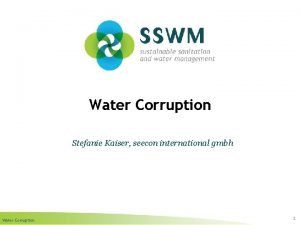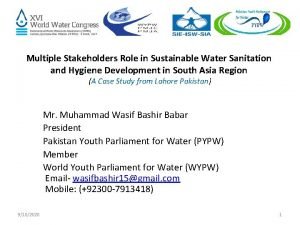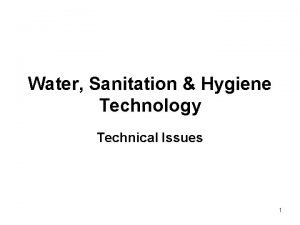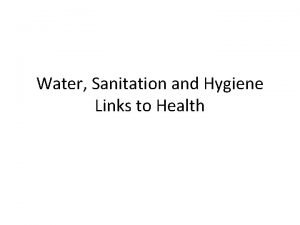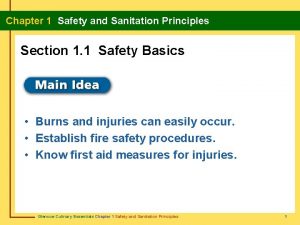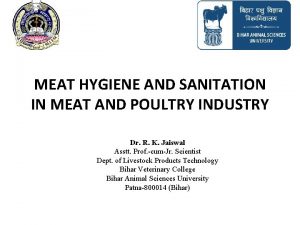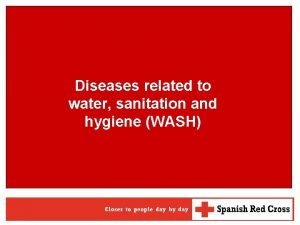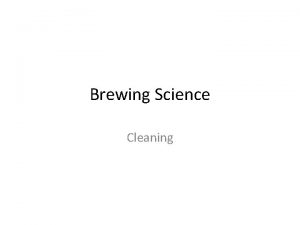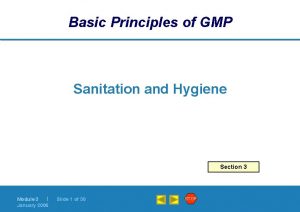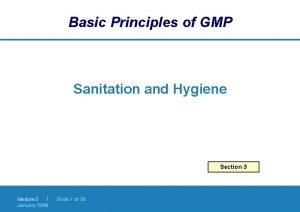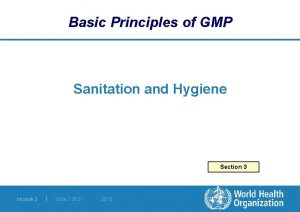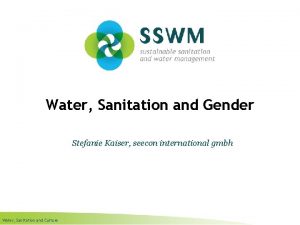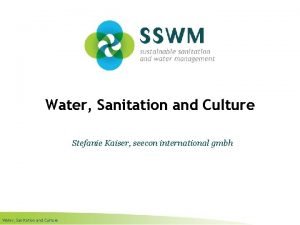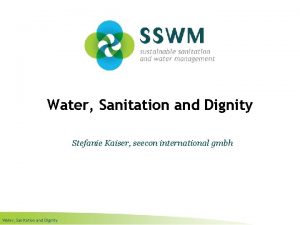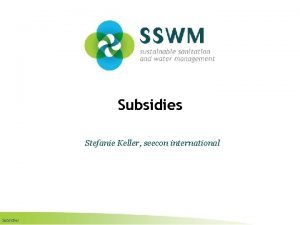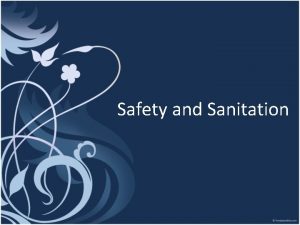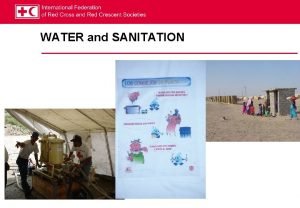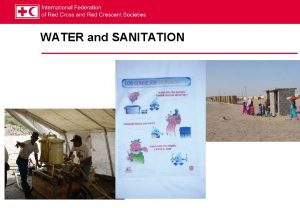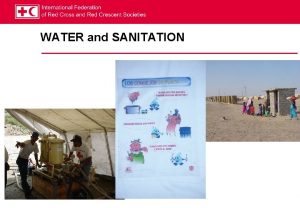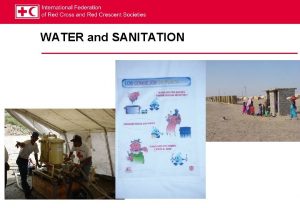Water Sanitation and Gender Stefanie Kaiser seecon international
















- Slides: 16

Water, Sanitation and Gender Stefanie Kaiser, seecon international gmbh Water, Sanitation and Culture

Find this presentation and more on: www. sswm. info. Copyright & Disclaimer Copy it, adapt it, use it – but acknowledge the source! Copyright Included in the SSWM Toolbox are materials from various organisations and sources. Those materials are open source. Following the opensource concept for capacity building and non-profit use, copying and adapting is allowed provided proper acknowledgement of the source is made (see below). The publication of these materials in the SSWM Toolbox does not alter any existing copyrights. Material published in the SSWM Toolbox for the first time follows the same open-source concept, with all rights remaining with the original authors or producing organisations. To view an official copy of the Creative Commons Attribution Works 3. 0 Unported License we build upon, visit http: //creativecommons. org/licenses/by/3. 0. This agreement officially states that: You are free to: • Share - to copy, distribute and transmit this document • Remix - to adapt this document. We would appreciate receiving a copy of any changes that you have made to improve this document. Under the following conditions: • Attribution: You must always give the original authors or publishing agencies credit for the document or picture you are using. Disclaimer The contents of the SSWM Toolbox reflect the opinions of the respective authors and not necessarily the official opinion of the funding or supporting partner organisations. Depending on the initial situations and respective local circumstances, there is no guarantee that single measures described in the toolbox will make the local water and sanitation system more sustainable. The main aim of the SSWM Toolbox is to be a reference tool to provide ideas for improving the local water and sanitation situation in a sustainable manner. Results depend largely on the respective situation and the implementation and combination of the measures described. An in-depth analysis of respective advantages and disadvantages and the suitability of the measure is necessary in every single case. We do not assume any responsibility for and make no warranty with respect to the results that may be obtained from the use of the information provided. Water, Sanitation and Gender

Find this presentation and more on: www. sswm. info. Contents 1. Introduction 2. Gender, Water and Sanitation 3. Gender and School Sanitation 4. Gender Issues in Sustainable Sanitation (Eco. San) 5. Gender Mainstreaming in Sanitation 6. References Water, Sanitation and Gender 3

Find this presentation and more on: www. sswm. info. 1. Introduction Water, Sanitation and Hygiene is one of the Most Observable Divides between Women and Men Societal barriers often restrict women’s involvement in decision-making processes. Source: www. wsp. org/wsp/content/2012 -cartoon-calendar [Accessed: 10. 2012] The provision of hygiene and sanitation are usually considered women’s tasks. Source: www. wsp. org/wsp/about/Cartoon%20 Calendars/2007%20 Calendar [Accessed: 10. 2012] Water, Sanitation and Gender

Find this presentation and more on: www. sswm. info. 1. Introduction Terminology • Gender identifies the social relationships between women and men. • In these, power differences play a major role. • Gender relations are context specific and change to altering circumstances. • There are various underlying factors of gender relations: • Class • Age • Race • Ethnicity • Culture • Religion • Urban/rural context Source: http: //utatravel. twoday. net/stories/4696879/ [Accessed: 10. 2012] Adapted from SUSANA (2009) Water, Sanitation and Gender 5

Find this presentation and more on: www. sswm. info. 1. Introduction Gender Equality - Vision of Human Rights • Vision of human rights incorporates the acceptance of equal and inalienable rights of women and men • Gender equality = Equal visibility, opportunities and participation of women and men in all spheres of public and private life. • However, gender inequality is one of the most pervasive forms of inequality worldwide. UN (2007) • But important progress is made (e. g. school enrolment) Gender equality is crucial for: ≈ • Well-being of individuals • Evolution of societies • Development of countries Adapted from SUSANA (2009) Water, Sanitation and Gender 6

Find this presentation and more on: www. sswm. info. 2. Gender, Water and Sanitation in the Daily Life of Women Water is necessary for a lot of women’s responsibilities: • Drinking • Care of the sick • Food production & preparation • Cleaning • Care of domestic animals • Washing • Personal hygiene • Waste disposal Women carrying water vessels. Source: CONRADIN (2007) • The provision of hygiene and sanitation are often considered women’s tasks. • Women have accumulated considerable knowledge about water resources, including location, quality and storage methods. Water, Sanitation and Gender 7

Find this presentation and more on: www. sswm. info. 2. Gender, Water and Sanitation Role of Women in Water and Sanitation Programs Despite their central role in water management, societal barriers often restrict women’s involvement in decisions regarding toilets, sanitation and water programs. . . Su. San. A (2009) Source: www. saltywaffle. com/social-medias-impacts-barriers [Accessed: 09. 10. 2012] . . . results in gender-specific failures: • toilets facing the street in which women feel insecure • public toilets not allowing for standing or squatting (hygiene) • flush toilets require more work for women • etc. Water, Sanitation and Gender Women’s involvement in decisions is crucial. Source: www. wsp. org/wsp/content/2012 -cartoon-calendar [Accessed: 03. 10. 20©] 8

Find this presentation and more on: www. sswm. info. 2. Gender, Water and Sanitation Safety and Privacy are Women’s Main Concerns for Sanitation HANNAN & ANDERSSON (2002 Women, more than men, suffer from: • Indignity to defecate and urinate in the open. • Risk of assault, rape outside the village as well as in urban areas. • Poor hygienic conditions of public sanitary facilities. • Waiting until dark, drinking less, ‘holding out’ or modifying their diets. • This causes physical harm and all kinds of health problems. COHRE et al. (2008) Source: www. wsp. org/wsp/content/2012 -cartoon-cale [Accessed: 03. 10. 2012] Water, Sanitation and Gender 9

Find this presentation and more on: www. sswm. info. 3. Gender and School Sanitation A Neglected Problem in Many Parts of the World Hygienic conditions are often very poor (e. g. missing of hand-washing facilities and separate individual cabins). Ô Girls at puberty miss school or even drop out of their schools (e. g. in rural Pakistan 50% of girls drop out of school in grade 2 -3). GWA (2006), HANNAN and ANDERSSON (2002), UNICEF (2008) Ô Lack of adequate toilets and hygiene in schools is a key critical barrier to girl school attendance and girls education. Source: www. fluor 100. com/Community_projects_Blog_Coment. aspx? id=115&projectid=2 [Accessed: 09. 10. 2012] Water, Sanitation and Gender 10

Find this presentation and more on: www. sswm. info. 4. Gender Issues in Sustainable Sanitation (Eco. San) Gender perspectives of sustainable sanitation projects have not been fully explored yet Positive Effects for Women: • Women’s attitudes towards reuse-oriented toilets seem more positive than those of men. • More willing to use the fertiliser. • Could play an important role in motivating and educating others to use reuse-oriented toilets. • Reduces work burden to provide water. Negative Effects for Women: • Sustainable sanitation systems require more work in cleaning, maintenance, and application of urine and faeces. • As women do much of that work, that could add to their work burden. • Use of urine diverting toilets is a little more complicated for women. Adapted from SUSANA (2009); HANNAN and ANDERSSON (2002) Water, Sanitation and Gender 11

Find this presentation and more on: www. sswm. info. 5. Gender Mainstreaming in Sanitation Integrate a Gender Perspective in Sustainable Sanitation Planning, Design and Implementation Gender mainstreaming = Assessing the implications for women and men of any planned action. ECOSOC (1997) Design Evaluation Making the concerns and experiences of women, as well as of men, an integral part of policies and programs. Implementation Monitoring Water, Sanitation and Gender 12

Find this presentation and more on: www. sswm. info. 5. Gender Mainstreaming in Sanitation Guiding Questions to Integrate a Gender Perspective Sustainable Sanitation Planning >> Design >> Implementation 1. Gender specific needs, interests & priorities? 4. Location & design reflect the needs of men & women? 2. Institutional barriers to involvement or access to resources? 5. Technology reflects women’s & men’s priorities & needs? 3. How will the program affect women & men? 6. Gender balance in decision-making? Adapted from SUSANA (2009); COHRE et al. (2008); UN WATER (2006); ADB (1998; 2006); UNICEF (2008) and VAN WIJK-SYBESMA (1998) Water, Sanitation and Gender 13

Find this presentation and more on: www. sswm. info. 6. References ADB (Editor) (1998): Gender Guidelines in Water Supply and Sanitation. Checklist. Manila: Asian Development Bank. ADB (Editor) (2006): Setting the Scene: Water, Poverty, and the MDGs. Asia Water Watch 2015. Manila: Asian Development Bank. URL: www. pdfio. com/k-537399. html [Accessed: 17. 04. 2012]. COHRE (Editor); WATERAID SDC (Editor); UN-HABITAT (Editor) (2008): Sanitation: A human Rights Imperative. Geneva: Centre on Housing Rights and Evictions (COHRE). ECOSOC (Editor) (1997): Mainstreaming the gender perspective into all policies and agendas in the United Nations system. New York: United Nations Economic and Social Council (UN ECOSOC). GWA (2006): Sanitation and Hygiene. Chapter 3. 4. In: Gender and IWRM Resource Guide. URL: www. genderandwater. org/url/476. html [Accessed: 10. 2012]. HANNAN, C. ; ANDERSSON, I. (Editor) (2002): Gender Perspectives on Ecological Sanitation. Stockholm: Eco. San. Res. URL: www. ecosanres. org/pdf_files/Nanning_PDFs/Eng/Hannan%20&%20 Andersson. pdf [Accessed: 26. 08. 2010]. SUSANA (Editor) (2009): Su. San. A Factsheet: Integrating a Gender Perspective in Sustainable Sanitation. Eschborn: Sustainable Sanitation Alliance Working Group on Gender. URL: www. susana. org/langen/%0 Dlibrary? view=ccbktypeitem&type=2&id=1187 [Accessed: 10. 2012]. UN (Editor) (2007): The Millennium Development Goals Report. New York: United Nations (UN). URL: www. un. org/%0 Dmillenniumgoals/pdf/mdg 2007. pdf [Accessed: 26. 08. 2010]. UNICEF (Editor) (2008): Water, Environment and Sanitation. 10 Key Points to Check for Gender Equity; a checklist for managers of water and sanitation programs. New York: United Nation’s Children’s Fund. URL: www. unicef. org/wash/%0 Dindex_key_points. html [Accessed: 26. 08. 2010]. Water, Sanitation and Gender 14

Find this presentation and more on: www. sswm. info. 6. References UN WATER (Editor) (2006): Gender, Water and Sanitation: a Policy Brief. New York: United Nations (UN). URL: www. unwater. org/downloads/unwpolbrief 230606. pdf [Accessed: 26. 08. 2010]. VAN WIJK-SYBESMA, C. (1998): Gender in Water Resources Management, Water Supply and Sanitation: roles and realities revisited. Delft: International Water and Sanitation Centre (IRC). URL: www. irc. nl/page/1893 [Accessed: 26. 08. 2010]. Water, Sanitation and Gender 15

“Linking up Sustainable Sanitation, Water Management & Agriculture” SSWM is an initiative supported by: Created by: Water, Sanitation and Culture 16
 Seecon international gmbh
Seecon international gmbh Stefanie keller
Stefanie keller Stefanie kaiser
Stefanie kaiser Water and water and water water
Water and water and water water Stakeholders in water and sanitation
Stakeholders in water and sanitation Seecon
Seecon Strategic gender needs and practical gender needs
Strategic gender needs and practical gender needs Sanitation and hygiene
Sanitation and hygiene Sanitation and hygiene
Sanitation and hygiene Chapter 1 safety and sanitation principles
Chapter 1 safety and sanitation principles Poultry hygiene and sanitation
Poultry hygiene and sanitation Sanitation and hygiene
Sanitation and hygiene Cleaning and sanitation manual for breweries
Cleaning and sanitation manual for breweries Gmp sanitation and hygiene
Gmp sanitation and hygiene Gmp sanitation and hygiene
Gmp sanitation and hygiene Gmp sanitation and hygiene
Gmp sanitation and hygiene Compendium of sanitation systems and technologies
Compendium of sanitation systems and technologies


